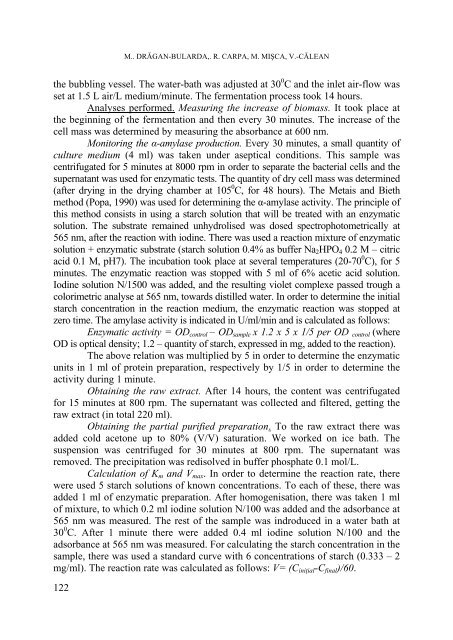biologia - Studia
biologia - Studia
biologia - Studia
You also want an ePaper? Increase the reach of your titles
YUMPU automatically turns print PDFs into web optimized ePapers that Google loves.
M.. DRĂGAN-BULARDA,. R. CARPA, M. MIŞCA, V.-CĂLEAN<br />
the bubbling vessel. The water-bath was adjusted at 30 0 C and the inlet air-flow was<br />
set at 1.5 L air/L medium/minute. The fermentation process took 14 hours.<br />
Analyses performed. Measuring the increase of biomass. It took place at<br />
the beginning of the fermentation and then every 30 minutes. The increase of the<br />
cell mass was determined by measuring the absorbance at 600 nm.<br />
Monitoring the α-amylase production. Every 30 minutes, a small quantity of<br />
culture medium (4 ml) was taken under aseptical conditions. This sample was<br />
centrifugated for 5 minutes at 8000 rpm in order to separate the bacterial cells and the<br />
supernatant was used for enzymatic tests. The quantity of dry cell mass was determined<br />
(after drying in the drying chamber at 105 0 C, for 48 hours). The Metais and Bieth<br />
method (Popa, 1990) was used for determining the α-amylase activity. The principle of<br />
this method consists in using a starch solution that will be treated with an enzymatic<br />
solution. The substrate remained unhydrolised was dosed spectrophotometrically at<br />
565 nm, after the reaction with iodine. There was used a reaction mixture of enzymatic<br />
solution + enzymatic substrate (starch solution 0.4% as buffer Na 2 HPO 4 0.2 M – citric<br />
acid 0.1 M, pH7). The incubation took place at several temperatures (20-70 0 C), for 5<br />
minutes. The enzymatic reaction was stopped with 5 ml of 6% acetic acid solution.<br />
Iodine solution N/1500 was added, and the resulting violet complexe passed trough a<br />
colorimetric analyse at 565 nm, towards distilled water. In order to determine the initial<br />
starch concentration in the reaction medium, the enzymatic reaction was stopped at<br />
zero time. The amylase activity is indicated in U/ml/min and is calculated as follows:<br />
Enzymatic activity = OD control – OD sample x 1.2 x 5 x 1/5 per OD control (where<br />
OD is optical density; 1.2 – quantity of starch, expressed in mg, added to the reaction).<br />
The above relation was multiplied by 5 in order to determine the enzymatic<br />
units in 1 ml of protein preparation, respectively by 1/5 in order to determine the<br />
activity during 1 minute.<br />
Obtaining the raw extract. After 14 hours, the content was centrifugated<br />
for 15 minutes at 800 rpm. The supernatant was collected and filtered, getting the<br />
raw extract (in total 220 ml).<br />
Obtaining the partial purified preparation. To the raw extract there was<br />
added cold acetone up to 80% (V/V) saturation. We worked on ice bath. The<br />
suspension was centrifuged for 30 minutes at 800 rpm. The supernatant was<br />
removed. The precipitation was redisolved in buffer phosphate 0.1 mol/L.<br />
Calculation of K m and V max . In order to determine the reaction rate, there<br />
were used 5 starch solutions of known concentrations. To each of these, there was<br />
added 1 ml of enzymatic preparation. After homogenisation, there was taken 1 ml<br />
of mixture, to which 0.2 ml iodine solution N/100 was added and the adsorbance at<br />
565 nm was measured. The rest of the sample was indroduced in a water bath at<br />
30 0 C. After 1 minute there were added 0.4 ml iodine solution N/100 and the<br />
adsorbance at 565 nm was measured. For calculating the starch concentration in the<br />
sample, there was used a standard curve with 6 concentrations of starch (0.333 – 2<br />
mg/ml). The reaction rate was calculated as follows: V= (C iniŃial -C final )/60.<br />
122
















